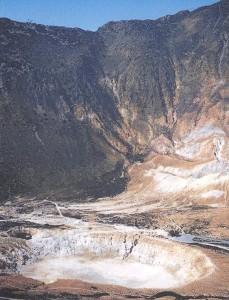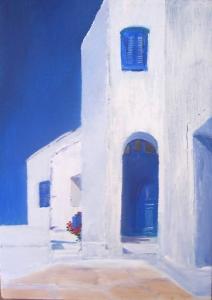Nissiros ...more on Nissiros
And those that held Nisyros, Crapathus, and Casos, with Cos, the city of Eurypylos, and the Calydnian islands, these were commanded by Pheidippos and Antiphos, two sons of King Thessalos the son of Hercules. And with them there came thirty ships. (Homer's Iliad; Written 800 B.C.E. Translated by Samuel Butler)
 The history of Nissiros is very similar to that of its neighbors, but its mythology is interesting. There once was a mean old giant called Polybotes, whom Poseidon, god of the sea, wanted to kill. He picked up a rock (actually a piece of the island of Kos!) and hurled it at the giant who was crushed, but not killed, beneath the rock. The rock was Nissiros, and the giant was now firmly trapped beneath it forever more. Rumbling, growling, and hissing (metaphors for earthquakes and volcanic eruptions), the giant continues to protest his entrapment to this day. The history of Nissiros is very similar to that of its neighbors, but its mythology is interesting. There once was a mean old giant called Polybotes, whom Poseidon, god of the sea, wanted to kill. He picked up a rock (actually a piece of the island of Kos!) and hurled it at the giant who was crushed, but not killed, beneath the rock. The rock was Nissiros, and the giant was now firmly trapped beneath it forever more. Rumbling, growling, and hissing (metaphors for earthquakes and volcanic eruptions), the giant continues to protest his entrapment to this day.
Situated just about in the center of the island and accessed by the main road, the volcano is an awesome sight, more moonlike that earthlike. The main crater has a diameter of 260 meters and a depth of 30 meters. Surrounding the crater is the moonlike uneven landscape of yellow sulfur, black rock, and green vegetation that somehow seems to thrive here! If you're wearing good thick-soled shoes, for the floor of the crater is hot, then you can actually descend to the floor of the crater, even  though steam and sulfuric dioxide fumes still spew from its vents. The volcano’s first massive explosion was around 600 B.C., and its last was in 1873. There are regular tours conducted to the volcano, but you can also go off on your own and explore the main crater, plus the other two craters further northwest. The main paved road from town leads to the entry point of the volcano. though steam and sulfuric dioxide fumes still spew from its vents. The volcano’s first massive explosion was around 600 B.C., and its last was in 1873. There are regular tours conducted to the volcano, but you can also go off on your own and explore the main crater, plus the other two craters further northwest. The main paved road from town leads to the entry point of the volcano.
Once in this region, continue south on the paved road and visit the pretty village lying in the south of the island called Nikia. This lovely village of whitewashed houses has an elevation of about 400 meters and has great views toward the crater in one direction, and toward the sea in the other looking at the island of Tilos. Refreshments are available in this village of less than 100 inhabitants. Not far from the village is the monastery of Ai. Ioannis Theologos, which has some very nice icons and frescoes. Heading back toward town on the main road, you can divert to the monastery of Panagia Kyra, which stands 450 meters above the sea and has an outstanding view. Again back on the main road, you will come to the now nearly abandoned village of Emborios for another excellent view of the volcano.
The main road continues north and arrives to the resort area of Palli, a pretty fishing village with tavernas, accommodation, and some bars. It has a sandy beach, but a better one will be found following the road to the east. The paved part turns into a dirt track and leads you to the pretty cove of Lies. From here, you can walk further south along the coast to Pachia Ammos, with its pretty sand dunes. Between Palli and Mandraki, there is another beach called White Beach, which is not far from the spa of Loutra. From the capital and moving southwest along the coast, there is the black volcanic pebble beach called Hochlakia. This is within easy walking distance of the capital.
|
|



